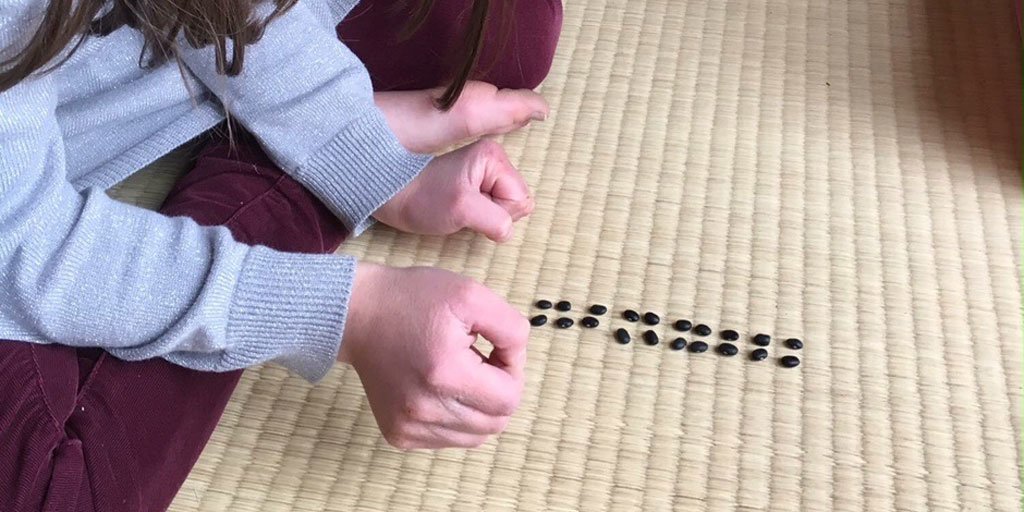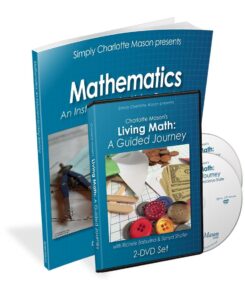Free shipping on USA orders over $129!
(Here is another great post from Richele Baburina, author of the Charlotte Mason math handbook, Mathematics: An Instrument for Living Teaching, and its corresponding DVD set, Charlotte Mason’s Living Math: A Guided Journey.)
I picked up my car from the airport’s long-term parking lot and, anxious to see my family, determined to take an unfamiliar shortcut home. Road signs and street lamps quickly ended on the tiny mountain road. Cell-phone service was lost next, and soon, so was I.
As I backtracked to almost the start of my route, Pippin’s warning to Frodo that “Shortcuts make long delays” sang in my head. I veered my car onto a well-marked and well-lit road, dismayed that my rush had cost me an additional thirty minutes rather than saving ten.
There are shortcuts that should never be taken, and Charlotte Mason recognized this in the teaching of arithmetic to young learners. Rushing a child into rows of figures without allowing ample time in the concrete stage is one of them. The child who is given time to explore numbers and prove mathematical facts using concrete objects will progress to mental and abstract work without feeling lost or having to backtrack.
It would be simplistic to say a Charlotte Mason approach to arithmetic is “manipulative-based,” though. Charlotte knew that, although concrete work is an important first step, it is only one step on the path to mathematical thinking. Once a child has worked freely with manipulatives, they are put away after the idea is conveyed, a fact proven, or a level of comfort in working with a concept achieved—and especially before boredom sets in. Nothing artificial is introduced in the way of specially-developed manipulatives or expensive equipment. In fact, Charlotte shunned contrived manipulatives, as an inordinate emphasis is placed on the object rather than on the concept it is meant to convey. She tells us,
“Therefore I incline to think that an elaborate system of staves, cubes, etc., instead of tens, hundreds, thousands, errs by embarrassing the child’s mind with too much teaching, and by making the illustration occupy a more prominent place than the thing illustrated” (Home Education, p. 262).
Rather, Charlotte suggested a number of everyday objects such as a bag of beans, simple counters, fingers, coins, balls, dominoes, and beads. Everyday objects convey ideas simply in a child’s natural environment, while the variety shows that facts are general and not dependent upon a specific manipulative in use.
While Charlotte recognized that children get the basic truth of number by means of their senses, she also knew that there was a progression from concrete work to mental imagining to abstract thinking. For example, the exploration of the number 8 would progress through simple lessons like this:
A child counts out 8 beans and then a number of questions are posed to him, such as “2 beans and 6 beans make how many beans?” and “You have 3 beans but want 8 beans. How many more are needed?”
When the child is able to answer with confidence, beans are still used to obtain the answers but are called by other names. For example, “Macy has 4 books and her brother has 4 books. How many books have they in all?” or “Joseph has 6¢. How many more are needed to make 8¢?”
When answers come readily, the beans are put away and the child is encouraged to work with imagined objects to answer engaging little problems before advancing to pure number.
Plenty of time is given to each step; and when the next number or a new concept is introduced, different objects are used. If, at any point, the child needs to go back to the concrete to get an answer, there is freedom to do so while continuing to cultivate his comfort with numbers. As Charlotte points out,
“. . . having used eyes and fingers upon ten balls or twenty balls, upon ten nuts, or leaves, or sheep, or what not, the child has formed the association of a given number with objects, and is able to conceive of the association of various other numbers with objects. In fact, he begins to think in numbers and not in objects, that is, he begins mathematics” (Home Education, p. 262).
While excessive emphasis on contrived manipulatives is avoided in the Charlotte Mason approach to arithmetic, simple everyday objects and a variety of them are instrumental to a child’s investigation of numbers. For the early learner, time to work with manipulatives and being sure to put them away when no longer needed are both natural first steps not to be bypassed on the road to thinking mathematically.
More Charlotte Mason Math
Get all the details about how Charlotte Mason taught math from first grade through twelfth in Mathematics: An Instrument for Living Teaching. Add the Charlotte Mason’s Living Math 2-DVD set for more than 3-1/2 hours of practical demonstrations of Charlotte’s approach to elementary math lessons. Purchase both together and save with special bundle pricing.
Podcast: Play in new window | Download



I love the simplicity of using everyday objects to solidify early mathematics in a child’s mind.